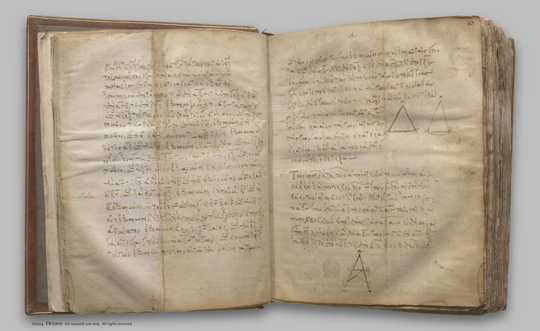index prev next | digilib folio 14

In isosceles triangles the angles at the base are equal to one another, and, if the equal straight lines be produced further, the angles under the base will be equal to one another.
| Τῶν ἰσοσκελῶν τριγώνων αἱ πρὸς τῇ βάσει γωνίαι ἴσαι ἀλλήλαις εἰσίν, καὶ προσεκβληθεισῶν τῶν ἴσων εὐθειῶν αἱ ὑπὸ τὴν βάσιν γωνίαι ἴσαι ἀλλήλαις ἔσονται. Ἔστω τρίγωνον ἰσοσκελὲς τὸ ΑΒΓ ἴσην ἔχον τὴν ΑΒ πλευρὰν τῇ ΑΓ πλευρᾷ, καὶ προσεκβεβλήσθωσαν ἐπ' εὐθείας ταῖς ΑΒ, ΑΓ εὐθεῖαι αἱ ΒΔ, ΓΕ: λέγω, ὅτι ἡ μὲν ὑπὸ ΑΒΓ γωνία τῇ ὑπὸ ΑΓΒ ἴση ἐστίν, ἡ δὲ ὑπὸ ΓΒΔ τῇ ὑπὸ ΒΓΕ. Εἰλήφθω γὰρ ἐπὶ τῆς ΒΔ τυχὸν σημεῖον τὸ Ζ, καὶ ἀφῃρήσθω ἀπὸ τῆς μείζονος τῆς ΑΕ τῇ ἐλάσσονι τῇ ΑΖ ἴση ἡ ΑΗ, καὶ ἐπεζεύχθωσαν αἱ ΖΓ, ΗΒ εὐθεῖαι. Ἐπεὶ οὖν ἴση ἐστὶν ἡ μὲν ΑΖ τῇ ΑΗ ἡ δὲ ΑΒ τῇ ΑΓ, δύο δὴ αἱ ΖΑ, ΑΓ δυσὶ ταῖς ΗΑ, ΑΒ ἴσαι εἰσὶν ἑκατέρα ἑκατέρᾳ: καὶ γωνίαν κοινὴν περιέχουσι τὴν ὑπὸ ΖΑΗ: βάσις ἄρα ἡ ΖΓ βάσει τῇ ΗΒ ἴση ἐστίν, καὶ τὸ ΑΖΓ τρίγωνον τῷ ΑΗΒ τριγώνῳ ἴσον ἔσται, καὶ αἱ λοιπαὶ γωνίαι ταῖς λοιπαῖς γωνίαις ἴσαι ἔσονται ἑκατέρα ἑκατέρᾳ, ὑφ' ἃς αἱ ἴσαι πλευραὶ ὑποτείνουσιν, ἡ μὲν ὑπὸ ΑΓΖ τῇ ὑπὸ ΑΒΗ, ἡ δὲ ὑπὸ ΑΖΓ τῇ ὑπὸ ΑΗΒ. καὶ ἐπεὶ ὅλη ἡ ΑΖ ὅλῃ τῇ ΑΗ ἐστιν ἴση, ὧν ἡ ΑΒ τῇ ΑΓ ἐστιν ἴση, λοιπὴ ἄρα ἡ ΒΖ λοιπῇ τῇ ΓΗ ἐστιν ἴση. ἐδείχθη δὲ καὶ ἡ ΖΓ τῇ ΗΒ ἴση: δύο δὴ αἱ ΒΖ, ΖΓ δυσὶ ταῖς ΓΗ, ΗΒ ἴσαι εἰσὶν ἑκατέρα ἑκατέρᾳ: καὶ γωνία ἡ ὑπὸ ΒΖΓ γωνίᾳ τῇ ὑπὸ ΓΗΒ ἴση, καὶ βάσις αὐτῶν κοινὴ ἡ ΒΓ: καὶ τὸ ΒΖΓ ἄρα τρίγωνον τῷ ΓΗΒ τριγώνῳ ἴσον ἔσται, καὶ αἱ λοιπαὶ γωνίαι ταῖς λοιπαῖς γωνίαις ἴσαι ἔσονται ἑκατέρα ἑκατέρᾳ, ὑφ' ἃς αἱ ἴσαι πλευραὶ ὑποτείνουσιν: ἴση ἄρα ἐστὶν ἡ μὲν ὑπὸ ΖΒΓ τῇ ὑπὸ ΗΓΒ ἡ δὲ ὑπὸ ΒΓΖ τῇ ὑπὸ ΓΒΗ. ἐπεὶ οὖν ὅλη ἡ ὑπὸ ΑΒΗ γωνία ὅλῃ τῇ ὑπὸ ΑΓΖ γωνίᾳ ἐδείχθη ἴση, ὧν ἡ ὑπὸ ΓΒΗ τῇ ὑπὸ ΒΓΖ ἴση, λοιπὴ ἄρα ἡ ὑπὸ ΑΒΓ λοιπῇ τῇ ὑπὸ ΑΓΒ ἐστιν ἴση: καί εἰσι πρὸς τῇ βάσει τοῦ ΑΒΓ τριγώνου. ἐδείχθη δὲ καὶ ἡ ὑπὸ ΖΒΓ τῇ ὑπὸ ΗΓΒ ἴση: καί εἰσιν ὑπὸ τὴν βάσιν. Τῶν ἄρα ἰσοσκελῶν τριγώνων αἱ πρὸς τῇ βάσει γωνίαι ἴσαι ἀλλήλαις εἰσίν, καὶ προσεκβληθεισῶν τῶν ἴσων εὐθειῶν αἱ ὑπὸ τὴν βάσιν γωνίαι ἴσαι ἀλλήλαις ἔσονται: ὅπερ ἔδει δεῖξαι. | In isosceles triangles the angles at the base are equal to one another, and, if the equal straight lines be produced further, the angles under the base will be equal to one another. Let ABC be an isosceles triangle having the side AB equal to the side AC; and let the straight lines BD, CE be produced further in a straight line with AB, AC. [Post. 2] I say that the angle ABC is equal to the angle ACB, and the angle CBD to the angle BCE. Let a point F be taken at random on BD; from AE the greater let AG be cut off equal to AF the less; [I. 3] and let the straight lines FC, GB be joined. [Post. 1] Then, since AF is equal to AG and AB to AC, the two sides FA, AC are equal to the two sides GA, AB, respectively; and they contain a common angle, the angle FAG. Therefore the base FC is equal to the base GB, and the triangle AFC is equal to the triangle AGB, and the remaining angles will be equal to the remaining angles respectively, namely those which the equal sides subtend, that is, the angle ACF to the angle ABG, and the angle AFC to the angle AGB. [I. 4] And, since the whole AF is equal to the whole AG, and in these AB is equal to AC, the remainder BF is equal to the remainder CG. But FC was also proved equal to GB; therefore the two sides BF, FC are equal to the two sides CG, GB respectively; and the angle BFC is equal to the angle CGB, while the base BC is common to them; therefore the triangle BFC is also equal to the triangle CGB, and the remaining angles will be equal to the remaining angles respectively, namely those which the equal sides subtend; therefore the angle FBC is equal to the angle GCB, and the angle BCF to the angle CBG. Accordingly, since the whole angle ABG was proved equal to the angle ACF, and in these the angle CBG is equal to the angle BCF, the remaining angle ABC is equal to the remaining angle ACB; and they are at the base of the triangle ABC. But the angle FBC was also proved equal to the angle GCB; and they are under the base. Therefore etc. |